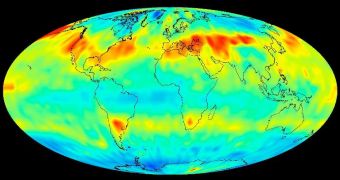Today, May 4, the NASA Aqua spacecraft and its six-instrument scientific suite are celebrating their 10th anniversary in Earth's orbit. Over the past decade, the satellite has provided experts with vast volumes of data on our planet's atmosphere, contributing to our understanding of the world as a whole.
The Atmospheric Infrared Sounder (AIRS) and the Advanced Microwave Sounding Unit (AMSU-A) are its most famous instruments, and also the ones that have produced the largest amount of scientific data over the course of the satellite's lifespan.
The spacecraft launched aboard a Delta II rocket from the Vandenberg Air Force Base (VAFB), on May 4, 2002. It was originally planned to conduct a 6-year mission, but extensions were subsequently approved when it showed no signs of fatigue.
Aqua is one of the most important satellites in the American space agency's Earth Observing System (EOS) program, alongside the Terra satellites (launched in 1999) and the Aura spacecraft (2004).
Aqua is also the leader of the A Train, a constellation of NASA satellites flying in a single row over the planet, which also includes Aura, CALIPSO, CloudSat and the French mission PARASOL. The formation leader flies in a Sun-synchronous orbit.
In addition to AIRS and AMSU-A, its suite includes the Advanced Microwave Scanning Radiometer-EOS (AMSR-E), the famous Moderate Resolution Imaging Spectroradiometer (MODIS), the Humidity Sounder for Brazil (HSB) and the Clouds and the Earth's Radiant Energy System (CERES).
As a whole, the Aqua mission's main goals are to study atmospheric water vapor concentrations, cloud covers, greenhouse gas distribution patterns, atmospheric temperatures and other similar aspects. Together, these data enable us to understand climate change trends at a global level with precision.
The spacecraft has also provided Earth scientists with a better understanding of the global water and energy cycles, as well as with more data on how the climate reacts to increased concentrations of atmospheric greenhouse gases.
“AIRS has performed beyond expectation, exceeding its mission objectives. The knowledge we've gained through AIRS has advanced our understanding of weather and climate, and demonstrated an important measurement technology,” Tom Pagano explains.
“While the team can be proud of what's been accomplished, we continue to look forward to new discoveries as we explore the connection between extreme weather and climate change,” adds the expert, who is the AIRS project manager at the NASA Jet Propulsion Laboratory, in Pasadena.
Aqua has the potential to remain in orbit until 2022, when its fuel will run out. If nothing unexpected happens, the mission may very well continue to provide climate data for yet another decade.

 14 DAY TRIAL //
14 DAY TRIAL //